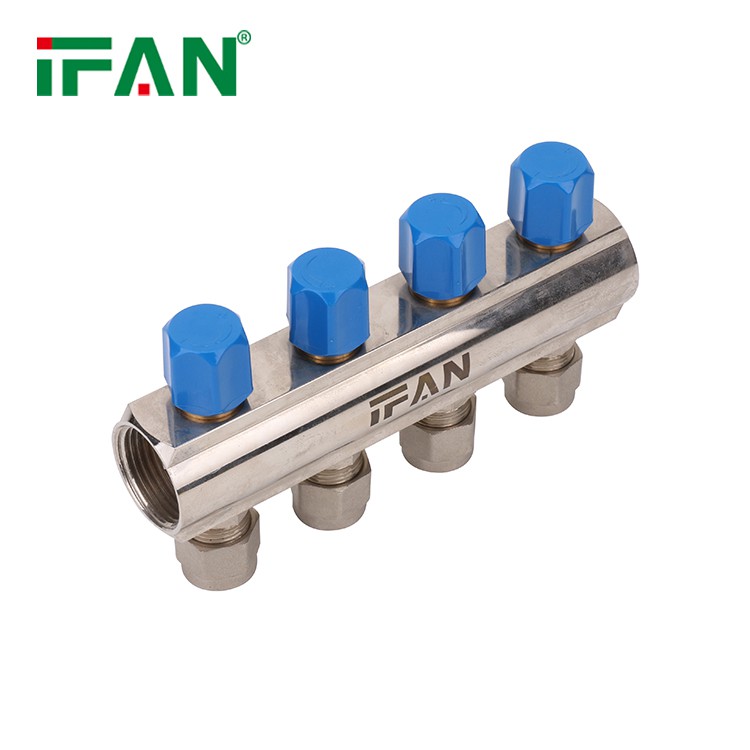The floor heating manifold is a crucial component of a hydronic floor heating system. It serves as the central distribution point for hot water or heating fluid to be supplied to individual heating circuits within the building. The manifold ensures proper balancing and control of the heat distribution, allowing for efficient and comfortable heating in each zone or room. In this guide, we will provide a basic introduction to the floor heating manifold and explain its working principle.
Function of the Floor Heating Manifold: The main function of the floor heating manifold is to control and distribute the flow of heated water or heating fluid to individual heating circuits. It acts as a central hub where the supply pipe from the heat source (e.g., boiler, heat pump) connects to multiple return pipes that lead to different heating zones or rooms.

Components of the Floor Heating Manifold: A typical floor heating manifold consists of several key components:
a. Supply and Return Connections: The manifold has inlet and outlet connections for the supply and return pipes. The supply connection receives the heated water from the heat source, while the return connection carries the cooled water back to the heat source for reheating.
b. Flow Meters: Flow meters are built into each individual circuit to measure the flow rate of water passing through that specific circuit. This helps in balancing the system, ensuring uniform heat distribution across all zones.
c. Isolation Valves: Isolation valves are installed on both the supply and return sides of each circuit, allowing for individual shut-off control and maintenance of specific zones without affecting the entire system.
d. Balancing Valves: Balancing valves help regulate the flow of water to each circuit. By adjusting the flow rate using these valves, the system can be balanced to deliver the desired heat output to each zone.
e. Mixing Valve: In some systems, a mixing valve may be incorporated into the manifold to control the temperature of the heated water before it is distributed to the circuits. This allows for precise temperature control in each zone.
f. Air Vent: An air vent or bleed valve is typically included to remove any trapped air from the system, ensuring proper water circulation and preventing airlocks.
g. Temperature Gauges: Temperature gauges may be installed on the supply and return connections to monitor the temperature of the heating fluid.

Working Principle of the Floor Heating Manifold: The working principle of a floor heating manifold involves the following steps:
a. Heat Source: The heated water or heating fluid is supplied from the heat source, such as a boiler or heat pump, and enters the supply connection of the manifold. The temperature of the incoming water is controlled based on the system requirements.
b. Distribution to Circuits: From the supply connection, the heated water is distributed to the individual circuits via the flow meters and balancing valves. These components regulate the flow rate and ensure an even distribution of heat throughout the system.
c. Balancing and Control: The flow meters and balancing valves allow for precise balancing and control of the heat output to each zone or room. By adjusting the flow rates, the temperature and comfort levels can be maintained uniformly across the building.
d. Return Path: After circulating through the heating circuits, the cooled water returns to the manifold via the return connections. The return path may incorporate a mixing valve to adjust the temperature of the return water if necessary.
e. Reheating: The returned cooled water is then sent back to the heat source (boiler or heat pump) for reheating and recirculation through the system.
f. Monitoring and Maintenance: The manifold may include temperature gauges and an air vent to monitor the system's performance and allow for maintenance tasks such as bleeding out trapped air.
By efficiently controlling the flow and temperature of the heating fluid to each heating circuit, the floor heating manifold ensures uniform heat distribution and optimal comfort levels throughout the building.
Final Note: It is important to consult with a professional HVAC engineer or a reputable floor heating system provider during the design and installation of a floor heating manifold. They can help ensure proper sizing, component selection, and system configuration for your specific heating requirements. Regular maintenance and periodic checks of the manifold will also contribute to the overall efficiency and longevity of the floor heating system.
